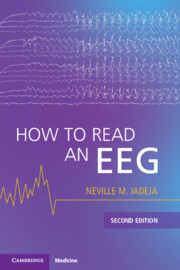Book contents
- How to Read an EEG
- Reviews
- How to Read an EEG
- Copyright page
- Dedication
- Contents
- Figure Contributions
- Foreword to the First Edition
- Preface
- How to Read This Book
- Part I Basics
- Part II Interpretation
- Chapter 7 Approach to EEG Reading
- Chapter 8 Describing Abnormalities
- Chapter 9 Artifacts
- Chapter 10 Normal Variants
- Chapter 11 Sporadic Abnormalities
- Chapter 12 Repetitive Abnormalities
- Chapter 13 Ictal Patterns (Electrographic Seizures)
- Chapter 14 Activation Procedures
- Part III Specific Conditions
- Appendix: How to Write a Report
- Index
- References
Chapter 13 - Ictal Patterns (Electrographic Seizures)
from Part II - Interpretation
Published online by Cambridge University Press: aN Invalid Date NaN
- How to Read an EEG
- Reviews
- How to Read an EEG
- Copyright page
- Dedication
- Contents
- Figure Contributions
- Foreword to the First Edition
- Preface
- How to Read This Book
- Part I Basics
- Part II Interpretation
- Chapter 7 Approach to EEG Reading
- Chapter 8 Describing Abnormalities
- Chapter 9 Artifacts
- Chapter 10 Normal Variants
- Chapter 11 Sporadic Abnormalities
- Chapter 12 Repetitive Abnormalities
- Chapter 13 Ictal Patterns (Electrographic Seizures)
- Chapter 14 Activation Procedures
- Part III Specific Conditions
- Appendix: How to Write a Report
- Index
- References
Summary
Ictal patterns represent ongoing electrographic seizures. They are recognized by their clinical accompaniments, which may be subtle and their electrographic features. Evolution is the hallmark of an ictal pattern. “Plus” terms also render a pattern to be more ictal in appearance. Typically, electrographic seizures have a clear evolution between onset and offset and a duration of 10 seconds or more. They are common in critically ill patients and are diagnosed on continuous EEG monitoring. Brief potentially ictal rhythmic discharges (BIRDs) are asymptomatic short duration (less than 10 seconds) patterns strongly associated with epileptic seizures. [101 words/619 characters]
Information
- Type
- Chapter
- Information
- How to Read an EEG , pp. 191 - 207Publisher: Cambridge University PressPrint publication year: 2025
References
Accessibility standard: WCAG 2.2 AAA
Content Navigation
Allows you to navigate directly to chapters, sections, or non‐text items through a linked table of contents, reducing the need for extensive scrolling.
Provides an interactive index, letting you go straight to where a term or subject appears in the text without manual searching.
Reading Order & Textual Equivalents
You will encounter all content (including footnotes, captions, etc.) in a clear, sequential flow, making it easier to follow with assistive tools like screen readers.
You get concise descriptions (for images, charts, or media clips), ensuring you do not miss crucial information when visual or audio elements are not accessible.
You get more than just short alt text: you have comprehensive text equivalents, transcripts, captions, or audio descriptions for substantial non‐text content, which is especially helpful for complex visuals or multimedia.
Visual Accessibility
You will still understand key ideas or prompts without relying solely on colour, which is especially helpful if you have colour vision deficiencies.
You benefit from high‐contrast text, which improves legibility if you have low vision or if you are reading in less‐than‐ideal lighting conditions.
